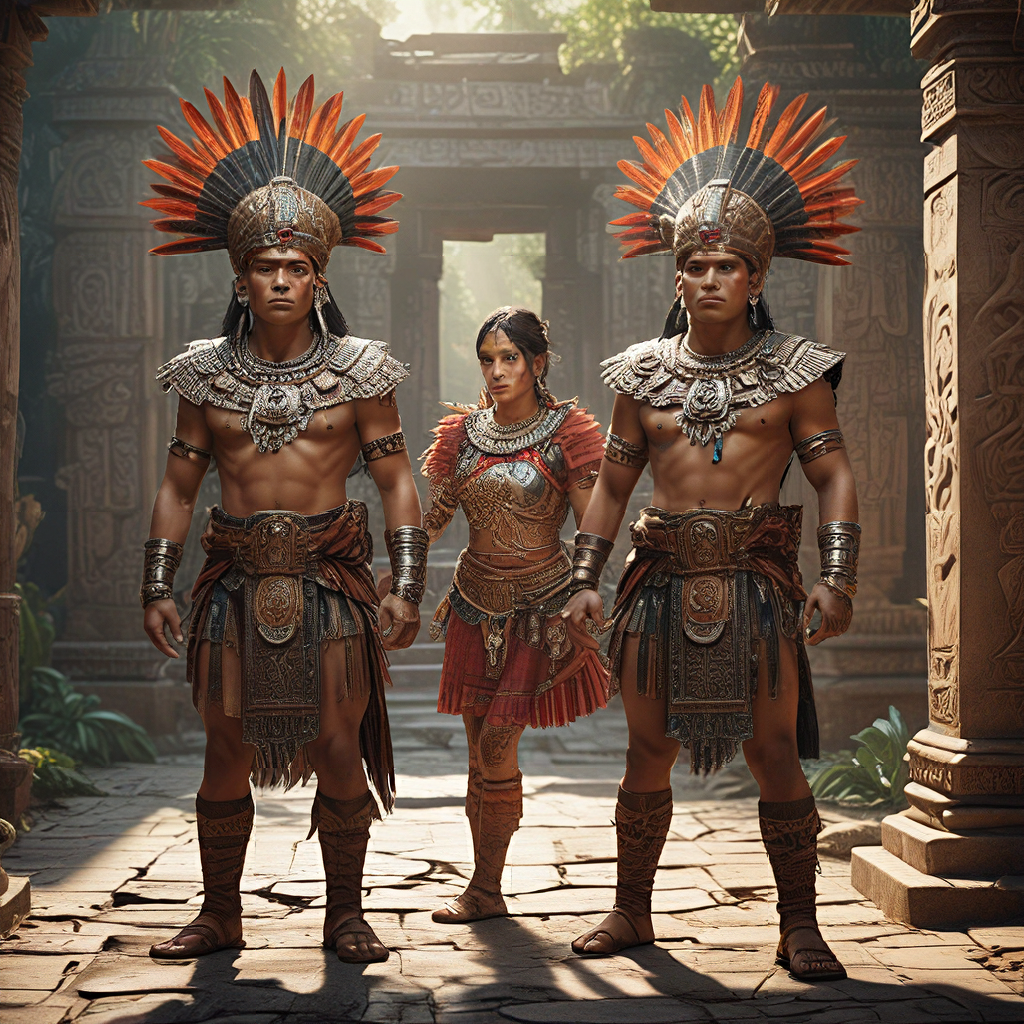Xipe Totec: The God of Agriculture, Rebirth, and Sacrifice
In the pantheon of Aztec deities, Xipe Totec stands out as a figure shrouded in both fascination and unease. Known as the "Flayed God," he was a complex deity associated with agriculture, rebirth, and, most chillingly, human sacrifice. While his role in Aztec society was multifaceted, his iconography and rituals centered around the act of flaying, a practice that continues to intrigue and disturb modern audiences.
The Story of Xipe Totec: A God of Paradox
The myth of Xipe Totec is a narrative of paradox, reflecting the duality inherent in his nature. His story often involves the sacrifice of a young man, sometimes depicted as a god himself. Through his sacrifice, Xipe Totec is reborn, shedding his mortal skin and taking on the guise of a god, a symbol of renewed life and bountiful harvests.
There are various versions of this myth, each highlighting different aspects of Xipe Totec's personality. In one account, he is said to have sacrificed himself to ensure the success of the maize harvest. In another, he is depicted as a trickster god, leading the unsuspecting into traps and then offering them up as sacrifices. This duality, the combination of life-giving and death-bringing aspects, is central to understanding Xipe Totec's complex role in Aztec culture.
The Flayed God: Xipe Totec’s Disturbing Iconography
Xipe Totec's iconography is perhaps the most striking element of his mythology. He is almost always depicted with flayed skin, often wearing it as a garment, his face obscured by a mask of human skin. This chilling image is far from a mere aesthetic choice; it is a powerful symbol that reflects Xipe Totec's association with sacrifice, rebirth, and the cycle of life and death.
The flayed skin represents the shedding of the old, the stripping away of the mortal, and the emergence of the new. Through this process, Xipe Totec embodies the promise of renewal, the promise of fertility and abundance. The disturbing nature of this imagery served as a visual reminder of the sacrifices necessary to ensure the continuation of life and the vitality of the land.
The Ritual of Flaying: A Symbolic Act of Renewal
The practice of flaying, while shocking to modern sensibilities, was a central part of Xipe Totec's cult. During his festivals, priests would perform ritual flayings, offering the skin of the sacrificed to the god. The flayed skin was then used to create masks and costumes worn in religious ceremonies, further emphasizing the connection between sacrifice and renewal.
The ritual flaying wasn't simply a brutal act. It was a symbolic gesture, a ritualistic reenactment of Xipe Totec's own sacrifice and rebirth. Through the flaying, the Aztec people enacted the cycle of life and death, seeking to appease the god and ensure the continuation of their way of life.
Xipe Totec and the Maize Harvest: A Vital Connection
The connection between Xipe Totec and the maize harvest is crucial to understanding his role in Aztec society. Maize was a staple crop, essential to the survival of the people. Xipe Totec's association with agriculture was deeply rooted in the belief that his sacrifice ensured the growth and abundance of the maize crop.
The flayed skin also symbolized the husk of the maize, the shedding of which reveals the precious kernels inside, representing the cycle of life and death, and the promise of abundance. Therefore, it is no coincidence that Xipe Totec's annual festival occurred during the spring, coinciding with the planting season, a time of renewal and hope. His presence was vital for the success of the harvest, and the Aztec people sought to honor him through rituals and sacrifices, ensuring his favor and the continued bounty of the earth.
Interpretations of Xipe Totec’s Role: A God of Contradictions
Xipe Totec's role in Aztec society was a complex tapestry woven with threads of life and death, renewal and sacrifice. He was both a benevolent god of agriculture and a fearsome deity demanding human sacrifices. This duality made him a challenging figure to comprehend, prompting various interpretations of his purpose.
Some scholars believe that Xipe Totec represented the inherent cycle of life and death, the constant renewal that sustains the natural world. They point to his association with maize and the spring planting season as evidence of his role as a god of fertility and abundance. The flaying, in this interpretation, symbolized the shedding of the old and the emergence of the new, a vital process for the continuation of life.
Others, however, highlight Xipe Totec's darker side, emphasizing his role as a god of sacrifice and war. They argue that the flaying rituals were a violent expression of Aztec religious beliefs, a way to appease the god and ensure his favor. This view sees Xipe Totec as a demanding deity, requiring the shedding of human blood to sustain the world.
Ultimately, Xipe Totec's role remains open to interpretation. He was a multifaceted deity, embodying the complexities of life and death, growth and decay. His story serves as a reminder that ancient religions were often intricate webs of beliefs, rituals, and symbolism, requiring careful study and interpretation.
Theorizing the Origins of Xipe Totec: Pre-Aztec Influences
The origins of Xipe Totec are shrouded in the mists of time, like many ancient deities. While his most prominent association is with the Aztecs, his origins likely predate their rise to power. Scholars believe that he was worshipped by various Mesoamerican cultures prior to the Aztec Empire, indicating a shared understanding of his significance.
One theory suggests that Xipe Totec's roots can be traced back to the Olmec civilization, which flourished in southern Mexico from around 1600 to 400 BCE. Olmec iconography features figures with flayed skin, hinting at a possible connection to the later cult of Xipe Totec.
Another possibility lies in the influence of the Teotihuacan civilization, a powerful empire that controlled much of Mesoamerica between 100 and 750 CE. Teotihuacan art features a deity with flayed skin, hinting at a possible predecessor to Xipe Totec, further suggesting that his worship predates the rise of the Aztecs.
The presence of similar deities with flayed skin throughout Mesoamerica suggests a widespread belief in the power of sacrifice and renewal, a common thread uniting various cultures in the region. Xipe Totec's story, therefore, is not simply an Aztec invention but a manifestation of a larger cultural understanding of the intertwined nature of life and death.
Xipe Totec and the Concept of Sacrifice: An Examination of Its Purpose
Human sacrifice played a crucial role in Aztec society, and Xipe Totec was intricately woven into this practice. While the idea of sacrifice is often seen as barbaric in the modern world, it was a central aspect of Aztec spiritual beliefs. It was not merely a violent act; it was a ritualistic offering intended to appease the gods and ensure the well-being of the people.
One interpretation suggests that sacrifices, particularly those offered to Xipe Totec, were a way to appease the god and ensure the bounty of the harvest. The flayed skin, symbolic of the shedding of the old and the emergence of the new, mirrored the cycle of life and death that sustains agriculture. By offering a life in sacrifice, the Aztecs believed they could ensure the continuation of their way of life, securing the vital resources they needed to survive.
Another perspective emphasizes the power dynamic between humans and gods. Sacrifices were seen as a way to maintain a delicate balance, demonstrating the Aztecs’ respect and submission to the divine. By offering the most precious thing they had – human life – they sought to appease the gods and avoid their wrath.
Though the practice of human sacrifice is undeniably disturbing, it is crucial to understand it within the context of Aztec beliefs. It was not simply a bloodthirsty act; it was a complex ritual with deep spiritual significance, intended to maintain order within the cosmic balance and ensure the well-being of the Aztec people.
Xipe Totec’s Legacy: A Lasting Influence on Mesoamerican Civilization
Xipe Totec's legacy extends beyond his role as an Aztec deity. His iconography, rituals, and stories have left an indelible mark on Mesoamerican culture, influencing the beliefs and practices of subsequent civilizations. His story, filled with both fear and reverence, continues to resonate with modern scholars and artists.
The imagery of the flayed god has become a powerful symbol of sacrifice, renewal, and the interconnectedness of life and death. It has inspired artistic expressions across various media, reminding us of the enduring power of ancient myths to shape our understanding of the world.
Xipe Totec's story serves as a reminder of the rich cultural tapestry of Mesoamerica, demonstrating the complexity and diversity of ancient beliefs. He is a testament to the enduring power of myth and symbolism to shape human understanding and inspire artistic expression, even centuries after his worship ceased.
Xipe Totec Today: Modern Interpretations and Artistic Representations
Xipe Totec, once a fearsome deity demanding human sacrifice, has been reinterpreted in the modern world, often depicted in artistic and cultural expressions. Though his original context is rooted in ancient Aztec beliefs, his symbolism has transcended time and continues to resonate with contemporary artists.
Modern artists, inspired by Xipe Totec's unsettling iconography and the myths surrounding him, have used his image to explore themes of sacrifice, rebirth, and the cycle of life and death. These expressions come in various forms, including paintings, sculptures, and performance art.
Some artists draw inspiration from the unsettling nature of the flayed god, using his image to depict the darkness and violence inherent in human nature. Others focus on the concept of renewal and transformation, using Xipe Totec as a symbol of hope and resilience in the face of adversity.
Xipe Totec's story continues to spark dialogue and debate, pushing artists to engage with complex themes, prompting deeper reflection on human nature and the interconnectedness of life and death.
FAQ
What is Xipe Totec, and what is he known for?
Xipe Totec is the Aztec god of agriculture, rebirth, and sacrifice. He is known as the "Flayed God" due to his unsettling iconography, often depicted with flayed skin.
What were the rituals associated with Xipe Totec?
The most notable ritual associated with Xipe Totec was the practice of flaying, where the skin of a sacrificed individual was offered to the god. Flayed skin was also used to create masks and costumes worn in religious ceremonies.
Why is Xipe Totec depicted with flayed skin?
The flayed skin symbolizes shedding the old, the stripping away of the mortal, and the emergence of the new. It represents the cycle of life and death and the promise of renewal and abundance associated with the god.
What is the significance of Xipe Totec's connection to maize?
Maize was a staple crop for the Aztec people, and Xipe Totec's association with agriculture was deeply rooted in the belief that his sacrifice ensured the growth and abundance of the maize harvest.
What is the lasting legacy of Xipe Totec?
Xipe Totec's story has left a lasting mark on Mesoamerican culture, influencing subsequent civilizations and inspiring artistic expression. His iconography and symbolism continue to resonate with modern artists and scholars.



